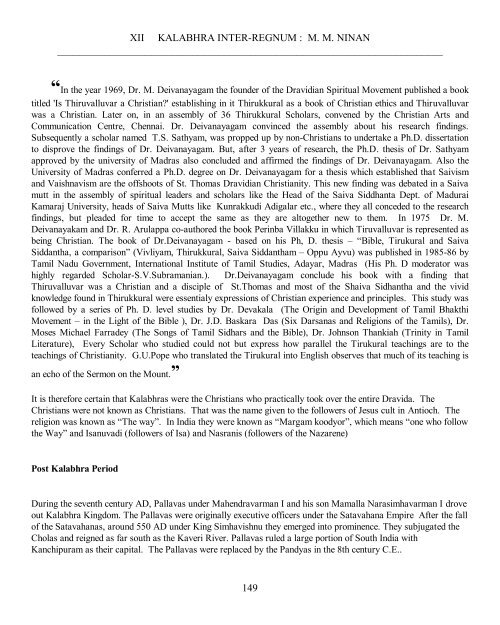Acts of Apostle Thomas
You also want an ePaper? Increase the reach of your titles
YUMPU automatically turns print PDFs into web optimized ePapers that Google loves.
XII KALABHRA INTER-REGNUM : M. M. NINAN<br />
__________________________________________________________________________<br />
“In the year 1969, Dr. M. Deivanayagam the founder <strong>of</strong> the Dravidian Spiritual Movement published a book<br />
titled 'Is Thiruvalluvar a Christian?' establishing in it Thirukkural as a book <strong>of</strong> Christian ethics and Thiruvalluvar<br />
was a Christian. Later on, in an assembly <strong>of</strong> 36 Thirukkural Scholars, convened by the Christian Arts and<br />
Communication Centre, Chennai. Dr. Deivanayagam convinced the assembly about his research findings.<br />
Subsequently a scholar named T.S. Sathyam, was propped up by non-Christians to undertake a Ph.D. dissertation<br />
to disprove the findings <strong>of</strong> Dr. Deivanayagam. But, after 3 years <strong>of</strong> research, the Ph.D. thesis <strong>of</strong> Dr. Sathyam<br />
approved by the university <strong>of</strong> Madras also concluded and affirmed the findings <strong>of</strong> Dr. Deivanayagam. Also the<br />
University <strong>of</strong> Madras conferred a Ph.D. degree on Dr. Deivanayagam for a thesis which established that Saivism<br />
and Vaishnavism are the <strong>of</strong>fshoots <strong>of</strong> St. <strong>Thomas</strong> Dravidian Christianity. This new finding was debated in a Saiva<br />
mutt in the assembly <strong>of</strong> spiritual leaders and scholars like the Head <strong>of</strong> the Saiva Siddhanta Dept. <strong>of</strong> Madurai<br />
Kamaraj University, heads <strong>of</strong> Saiva Mutts like Kunrakkudi Adigalar etc., where they all conceded to the research<br />
findings, but pleaded for time to accept the same as they are altogether new to them. In 1975 Dr. M.<br />
Deivanayakam and Dr. R. Arulappa co-authored the book Perinba Villakku in which Tiruvalluvar is represented as<br />
being Christian. The book <strong>of</strong> Dr.Deivanayagam - based on his Ph, D. thesis – “Bible, Tirukural and Saiva<br />
Siddantha, a comparison” (Vivliyam, Thirukkural, Saiva Siddantham – Oppu Ayvu) was published in 1985-86 by<br />
Tamil Nadu Government, International Institute <strong>of</strong> Tamil Studies, Adayar, Madras (His Ph. D moderator was<br />
highly regarded Scholar-S.V.Subramanian.). Dr.Deivanayagam conclude his book with a finding that<br />
Thiruvalluvar was a Christian and a disciple <strong>of</strong> St.<strong>Thomas</strong> and most <strong>of</strong> the Shaiva Sidhantha and the vivid<br />
knowledge found in Thirukkural were essentialy expressions <strong>of</strong> Christian experience and principles. This study was<br />
followed by a series <strong>of</strong> Ph. D. level studies by Dr. Devakala (The Origin and Development <strong>of</strong> Tamil Bhakthi<br />
Movement – in the Light <strong>of</strong> the Bible ), Dr. J.D. Baskara Das (Six Darsanas and Religions <strong>of</strong> the Tamils), Dr.<br />
Moses Michael Farradey (The Songs <strong>of</strong> Tamil Sidhars and the Bible), Dr. Johnson Thankiah (Trinity in Tamil<br />
Literature), Every Scholar who studied could not but express how parallel the Tirukural teachings are to the<br />
teachings <strong>of</strong> Christianity. G.U.Pope who translated the Tirukural into English observes that much <strong>of</strong> its teaching is<br />
an echo <strong>of</strong> the Sermon on the Mount.”<br />
It is therefore certain that Kalabhras were the Christians who practically took over the entire Dravida. The<br />
Christians were not known as Christians. That was the name given to the followers <strong>of</strong> Jesus cult in Antioch. The<br />
religion was known as “The way”. In India they were known as “Margam koodyor”, which means “one who follow<br />
the Way” and Isanuvadi (followers <strong>of</strong> Isa) and Nasranis (followers <strong>of</strong> the Nazarene)<br />
Post Kalabhra Period<br />
During the seventh century AD, Pallavas under Mahendravarman I and his son Mamalla Narasimhavarman I drove<br />
out Kalabhra Kingdom. The Pallavas were originally executive <strong>of</strong>ficers under the Satavahana Empire After the fall<br />
<strong>of</strong> the Satavahanas, around 550 AD under King Simhavishnu they emerged into prominence. They subjugated the<br />
Cholas and reigned as far south as the Kaveri River. Pallavas ruled a large portion <strong>of</strong> South India with<br />
Kanchipuram as their capital. The Pallavas were replaced by the Pandyas in the 8th century C.E..<br />
149


















